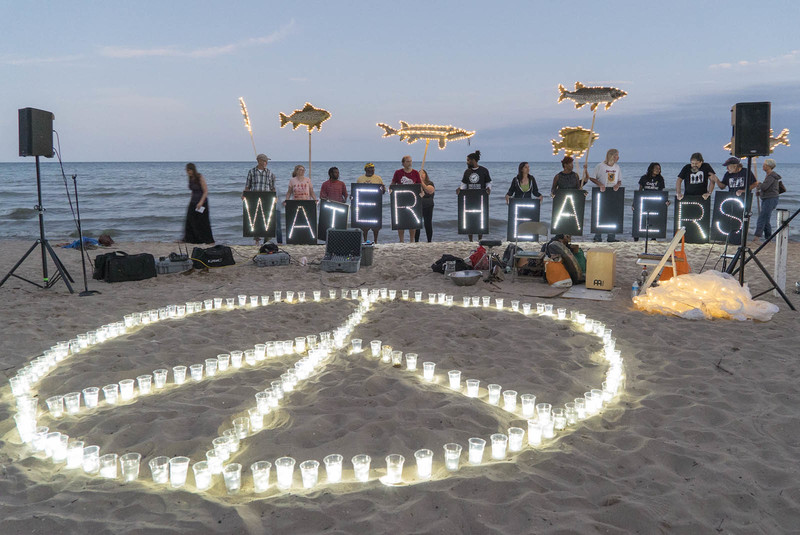Fans of Milwaukee – and Great Lakes – history who haven't signed up for the Wisconsin Marine Historical Society's mailing list are missing out.
The group – headquarted at Milwaukee Public Library, which I featured in this story a few years back – is very active in terms of collecting and archiving documents and photos and objects and also hosts numerous events each year.
The newsletter is an easy way to find a cool old photo in your inbox every week (sometimes more). And, because these folks are history buffs like the rest of us, there's always a story behind the photo and the WMHS folks share that story.
I especially enjoyed this one because I once got the chance to tour one of the vessels mentioned: the Ostrander. You can read that story here. Here is today's story from the Wisconsin Marine Historical Society:
This year, the Locks closed as scheduled at midnight on Jan. 15. Last boat through was the Burns Harbor, which was headed for winter lay-up in Superior. During the next two months, contractors will inspect, repair, and install upgrades at both the Poe and MacArthur Locks. This work is vital. More than 4,500 vessels lock through at the Sault annually. These carry nearly 80 million tons of cargo.

Twenty-seven boats tied up for winter in municipal mooring basin on west side
of Jones Island, December 1938.
(PHOTO: Great Lakes Marine Collection of the Milwaukee Public Library
and Wisconsin Marine Historical Society.)
During this period, a multitude of engineers, welders, pipe fitters, mechanics, and electricians around the Great Lakes will also be working to ensure the boats are ready to sail in 2020. It is estimated that U.S. flag carriers will invest nearly $97 million in maintenance and modernization on their fleets. Much of this work will be done in Wisconsin. Two of the four major shipyards on the Great Lakes are in the state: Fraser (Superior) and Fincantieri (Sturgeon Bay).
Some work will be performed in Milwaukee.
In 1931, Milwaukee contracted with the Edward E. Gillen Company to dredge a marshy area west of Jones Island that connected with the Kinnickinnic River. Initial plans called for a mooring basin wide enough to handle 10 vessels. It was later enlarged. Milwaukee's mooring basin became the winter home for several boats of U.S. Steel’s Pittsburgh Steamship Company, which operated the largest fleet on the Lakes. These were referred to as "tin stackers" because of their distinctive silver smokestacks.
The winter of 1938-39 was a record year for Milwaukee’s mooring basin. It hosted 27 boats, 22 of which were "tin stackers." Rental fees netted the city about $30 per month for each vessel. And since each boat spent an average of $5,000 making repairs and purchasing supplies for next season, Milwaukee merchants collected about $135,000. In 2019 dollars, that equates to almost $60,000 for the city and $2.45 million for local merchants.
Last winter, only Lafarge’s Tug/Barge G.L. Ostrander/Integrity used the mooring basin. Interlake Steamship’s thousand-footer Stewart J. Cort wintered at the port’s heavy lift dock, Prentiss Brown/St. Marys Conquest tied up at the company’s Kinnickinnic River terminal.
This year the Cort and the Ostrander/Integrity are back. To see them, stop by Harbor View Plaza at the east end of Greenfield Avenue near the UWM School of Freshwater Sciences. And to see more images of the mooring basin filled with tin stackers, check out Milwaukee Waterways, a digital collection of the Milwaukee Public Library. Just click the following link: Milwaukee Waterways.
Born in Brooklyn, N.Y., where he lived until he was 17, Bobby received his BA-Mass Communications from UWM in 1989 and has lived in Walker's Point, Bay View, Enderis Park, South Milwaukee and on the East Side.
He has published three non-fiction books in Italy – including one about an event in Milwaukee history, which was published in the U.S. in autumn 2010. Four more books, all about Milwaukee, have been published by The History Press. A fifth collects Urban Spelunking articles about breweries and maltsters.
With his most recent band, The Yell Leaders, Bobby released four LPs and had a songs featured in episodes of TV's "Party of Five" and "Dawson's Creek," and films in Japan, South America and the U.S. The Yell Leaders were named the best unsigned band in their region by VH-1 as part of its Rock Across America 1998 Tour. Most recently, the band contributed tracks to a UK vinyl/CD tribute to the Redskins and collaborated on a track with Italian novelist Enrico Remmert.
He's produced three installments of the "OMCD" series of local music compilations for OnMilwaukee.com and in 2007 produced a CD of Italian music and poetry.
In 2005, he was awarded the City of Asti's (Italy) Journalism Prize for his work focusing on that area. He has also won awards from the Milwaukee Press Club.
He has been heard on 88Nine Radio Milwaukee talking about his "Urban Spelunking" series of stories, in that station's most popular podcast.





